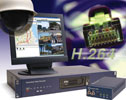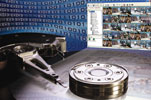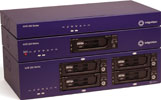

The increasing adoption of IP video CCTV systems by South African companies coupled with, in many instances, a 90-day-plus recording storage requirement, has highlighted the cost of storage associated with these systems.
Ettiene Swanepoel, technical director of Norbain South Africa, explains that IP-CCTV systems can easily, and cost-effectively, accommodate lengthy storage requirements if compression technology and storage architecture is carefully utilised.
To fully understand the storage issues associated with IP video security surveillance, it is necessary to explore the scale of the problem, NVR performance, storage architectures, data security, DVRs as an alternative and how the amount of video can be reduced.
The scale of the problem
The way in which video is compressed can make a significant difference to the storage requirements. This is because, comparing one system to another, of the four factors that affect how much disk storage is required, three (video resolution, frame-rate, number of cameras) remain constant while one (compression technology) varies.
Consider the following worked example for a typical system that compares an average compression with the very best that is available. The amount of digital data generated by a single camera results in:
Best compression: 20 GB/day
Average compression: 40 GB/day
This does not at first seem unmanageable since hard disk storage is inexpensive and 750 GB disks are readily available. However, assume a system with 100 cameras and the storage becomes:
Best compression: 2 TB/day
Average compression: 4 TB/day
Archiving recordings for 90 days gives:
Best compression: 180 TB
Average compression: 360 TB
This example highlights that the difference between an average compression and the best available is 180 TB of extra storage, and that is just for a relatively small system of 100 cameras.

NVR performance
When it comes to storage, the amount of data coming from the cameras to the NVRs is huge and continuous, so that the rate of writing data to the storage disk is constantly high. The processing overhead for writing and reading the video streams to disk is therefore an important factor in the overall performance of the NVR.
There can be a considerable difference in this overhead between different vendors of NVR software and it stands to reason that software which can minimise this processing will be able to handle many more camera streams per NVR. For example, the best NVR server software on the market has such a low CPU loading that 200 camera streams can be recorded on the lowest specification server PC. Therefore, in a large system with a 90-day recording requirement, the limitation on the server is its storage, not its processing power.
Storage architectures
Storage architectures are typically categorised as either centralised or distributed.
A typical centralised storage architecture would be used where a high density of cameras are located in one building, such as a casino. The NVRs would be located in one central IT facility, with a central network switch. Here, all of the video could be recorded on one server (however, this would almost certainly be storage limited, not CPU limited).
Using the worked example above with a 100-camera system, one option would be to use 10 NVR servers each fitted with an 18 TB disk array, assuming the system has the best compression technology available.
This is still a lot of hardware, but because the CPU utilisation is low, virtual servers1 can be deployed. Leading NVR vendors can run their software under applications such as VMware allowing 10 virtual servers to be configured on one physical server, considerably reducing equipment costs. In reality, a casino can use between 500 and 1000 cameras, so this approach is an important factor in keeping down costs.
Distributed storage architecture involves multiple locations, for example a rail network that could have 200 cameras located across 25 stations with on average eight cameras per station, with some stations only having four cameras. Here, a small and flexible storage architecture, which can use the right amount of storage for the right amount of cameras, is required.
For this example, assume 500 GB/camera is required for 90-day recording. An NVR with 2 TB could be deployed at each station, one NVR per four cameras. The smaller stations would have one NVR with the larger ones having five, a total of 50 NVRs for all 200 cameras. This would significantly reduce the bandwidth required from the network. If PC-based servers were used, then 50 separate servers would be required each with their own local attached storage, which comes at a significant cost. An alternative would be to use less expensive, dedicated, standalone NVR units that have the processing hardware and storage in a single compact unit.
So, when it comes to storage architecture, to satisfy different types of applications, a vendor needs to be able to provide a flexible and scalable recording solution that can use both PC server configurations and dedicated NVR units, if and when appropriate.
Data security
Storage of valuable data demands secure and reliable NVRs. Most PC based NVR servers will deploy redundant array of independent drives (RAID) disk arrays. These divide and/or replicate data among multiple hard drives according to the level of protection required. In a RAID 5 configuration for example, the data is striped across three separate disks so that, if any disk fails, no data is lost and the computer can continue without interruption.
Deploying dedicated NVR hardware provides additional levels of protection as standalone robust hardware units have redundant power supplies and network connections, RAID configurations and hot-swappable drives.
Any IP video system that deploys standalone NVR units should also have a flexible NVR backup strategy so that recordings can be automatically switched to a backup NVR or distributed amongst other NVRs in the system in the event of an NVR failure.

DVR vs NVR
So far, IP video systems and NVRs have dominated this discussion: what about traditional analogue CCTV systems that use digital video recorders (DVRs)? While DVRs and NVRs are both often termed 'digital', an NVR stores digital images directly from the IP-network and can be located anywhere on the network. In contrast, the DVR digitally compresses analogue video feeds and stores them on a hard-drive so that the term 'digital' refers to the compression and storage technology, not the transmitted video images. This means that the DVR has to be located near the analogue feeds and can only really be used in centralised architectures.
As the size of the system increases and the number of recording days increases there is no other option but to keep adding additional DVRs. This in itself is not a problem other than the cost overhead associated with the DVR. A high-end DVR would typically be able to record 16 cameras on to a 2 TB disk. Using our worked example for a casino and assuming the very best compression available, this would give just over six days of recording for all 16 cameras or 90 days for just one camera. Clearly, DVR technology is simply too expensive for large scale digital recording applications.
Reducing the amount of video - standards and intelligent recording
H.264 is the latest official video compression standard, which follows on from the highly successful MPEG-2 and MPEG-4 video standards. The most significant benefit of H.264 is the ability to deliver the same high-quality, low latency, digital video with savings of between 25% and 50% on bandwidth and therefore on the storage requirements. By selecting a system based on H.264 as opposed to MPEG-4, significant savings on storage can be achieved, particularly if the vendor's implementation of the standard is solid.
Furthermore, there is no point in recording video from a camera at full frame rate if there is nothing in the scene to record. Hence, IndigoVision's unique actively controlled framerate (ACF) streams video at a much lower frame rate when the scene is inactive but, as soon as the motion analysis software detects movement, the video is streamed at full frame rate. Similarly, analytics such as virtual tripwire can detect an object crossing a line and raise an alarm that initiates recording or increases the frame rate. Using these or similar applications can significantly reduce the amount of video and hence storage.
In conclusion, the requirement to store images for any substantial length of time such as 90+ days, will have a large impact on the storage requirement of the project and hence the cost. With larger systems the inflexibility and costs involved with an analogue/DVR solution means IP video is the only way forward. It is therefore paramount that the end user chooses an IP video solution that can deploy the very best compression technology and flexible and distributed NVR architectures, in order to minimise the additional costs due to the storage overhead.
Note 1:
An explanation of virtual servers - PC hardware was originally designed to run only a single operating system and a single application. Virtualisation breaks that bond, making it possible to run multiple operating systems and multiple applications on the same computer at the same time, increasing the utilisation and flexibility of hardware. Software such as VMware transforms or 'virtualises' the hardware resources of a PC (including the CPU, RAM, hard disk and network controller) to create a fully functional virtual machine that can run its own operating system and applications just like a 'real' computer. Multiple virtual machines share hardware resources without interfering with each other so that several operating systems and applications can safely be run at the same time on a single computer.
| Tel: | +27 87 802 2288 |
| Email: | [email protected] |
| www: | www.reditron.co.za |
| Articles: | More information and articles about Reditron |

© Technews Publishing (Pty) Ltd. | All Rights Reserved.